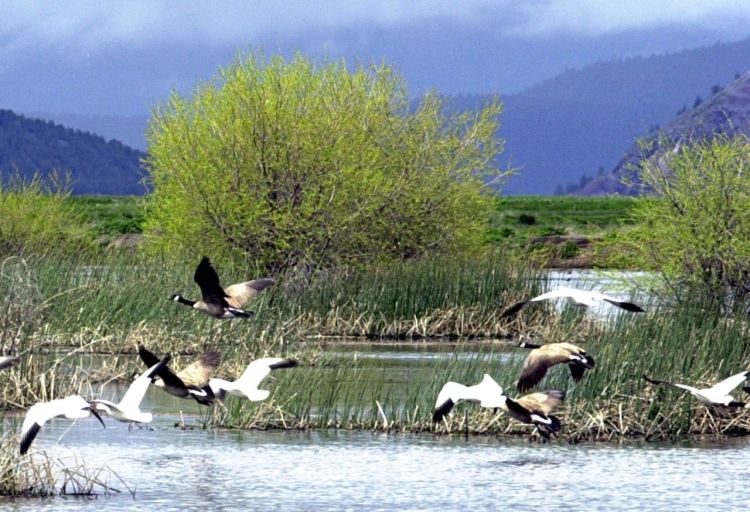Testing is still in progress to determine what caused the death of about 2,000 snow geese that were found in Idaho, the state’s Department of Fish and Game says.
The geese were migrating from Mexico to their Alaskan nesting grounds.
The suddenness of the birds’ death leads experts to suspect avian cholera, which kills acute sufferers in as little as six hours. “Basically, they just fell out of the sky,” Fish and Game spokesman Gregg Losinski told Reuters.
To prevent any other wildlife from picking up the disease, officials have collected and burned the carcasses, all found in the Mud Lake and Market Lake Wildlife Management Areas in the southeast region of the state.
“The important thing is to quickly collect as many of the carcasses as possible, to prevent other birds from feeding on the infected birds,” Upper Snake Regional Supervisor Steve Schmidt said in a statement on Monday. The carcasses were collected over the weekend.
While local wildlife populations are potentially at risk from avian cholera, humans are at a low risk of picking up an infection from the bacteria that causes the disease, officials said. It’s not clear where the geese may have contracted the illness, but Schmidt noted that avian cholera has “occurred sporadically in the region over the past few decades.”
Observers are already concerned about one group of scavenging birds spotted near the carcasses: about 20 bald eagles, a bird species that scavenges for food. But as Fish and Wildlife notes, avian cholera’s incubation period means that officials aren’t certain they’ll be able to locate the eagles “if and when the avian cholera affects them.”
Geese, coots, gulls and crows are the birds most commonly infected with avian cholera, the U.S. Geological Survey’s National Wildlife Health Center says. It’s spread a few different ways: from bird-bird contact, from contact with “secretions or feces” from an infected animal, or from ingesting bacteria-containing water and soil.
The bacteria that cause avian cholera can live in soil and water for months, the USGS adds. Aerosol transmission — in this case, from birds landing, splashing or otherwise disturbing a body of infected water and spraying it onto nearby birds — is also thought to be possible. The only way to stop an outbreak is to cull the flock of sick individuals, but sometimes that’s easier said than done: Some birds show no symptoms and carry the disease for life, causing acute outbreaks as soon as they encounter a susceptible flock.
Early symptoms can include lethargy, convulsions, a discharge from the mouth, matted feathers and erratic movements on the ground and in the air — including flying upside down, according to USGS. But many outbreaks of the disease are spotted only after the birds have died from it.
That’s because once birds become sick from the disease, they usually don’t have very long to live. Some contracting the acute form of the disease die within 6 to 12 hours of exposure, but more often, it takes 24 to 48 hours. Birds drop from the sky in otherwise “good body condition,” USGS says, “Death may be so rapid that birds literally fall out of the sky or die while eating with no previous signs of disease.”
Send questions/comments to the editors.



Success. Please wait for the page to reload. If the page does not reload within 5 seconds, please refresh the page.
Enter your email and password to access comments.
Hi, to comment on stories you must . This profile is in addition to your subscription and website login.
Already have a commenting profile? .
Invalid username/password.
Please check your email to confirm and complete your registration.
Only subscribers are eligible to post comments. Please subscribe or login first for digital access. Here’s why.
Use the form below to reset your password. When you've submitted your account email, we will send an email with a reset code.